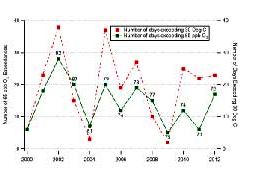Also discussed here: Despite significant reduction in smog-producing toxins, the Greater Toronto Area still violates Canada's standards for ozone air pollution (Kim Luke, Science Daily, Aug. 22, 2014)
Today we review recent measurements of pollutants included in the Canada Wide Air Quality Standards as they apply to the City of Toronto which has the largest population (of people as well as pollution emitting vehicles) and urban area of all cities in Canada. Resultrs indicate that despite a reduction in emissions of NO2 and PM2.5 of 27 to 50% over the last 4 years, Ozone (O3) exceeded the standards in 2012 at all eight monitoring stations. The authors speculate that this was due to the meteorology of that year which showed a large number of sunny days and light winds which contributed to the production of O3 (from NO2 emissions 63% of which come from from vehicles and O2). They also recommend that volatile organic compounds (VOCs)
be included in the standards.

Key Quotes:
“While the Greater Toronto Area has significantly reduced some of the toxins that contribute to smog, the city continues to violate the Canada-wide standards for ozone air pollution”
“since 2000, all sites experienced a decrease in NO2 of 28–62% and in measured VOC reactivity of at least 53–71 %....The city’s NOx emissions are dominated by the transportation sector (63 %), with diesel trucks accounting for a disproportionately large percentage (36 %)”
“These reductions are in line with the city's 2007 commitment to reducing smog precursors, and can be attributed to the implementation of pollution control measures like the Drive Clean program, and the closure of coal-fired power plants in the region”
“it was found that the Canada-wide Standard for ozone continues to be exceeded at all monitoring stations.”
“In Toronto, ground-level ozone is responsible for 13–29% of the incidences of premature mortality and hospitalizations associated with air pollution (with PM2.5 and NO2 being responsible for the remainder)”
"We are able to show that high ozone in 2012 was due to the relatively high number of sunny days that allowed ozone to be produced quickly, and low winds, that allowed the pollution to accumulate locally,"
“The importance of including OVOCs in O3 production analyses has been demonstrated, as short-term measurements indicate that they account for a significant fraction of OH reactivity”









No comments:
Post a Comment